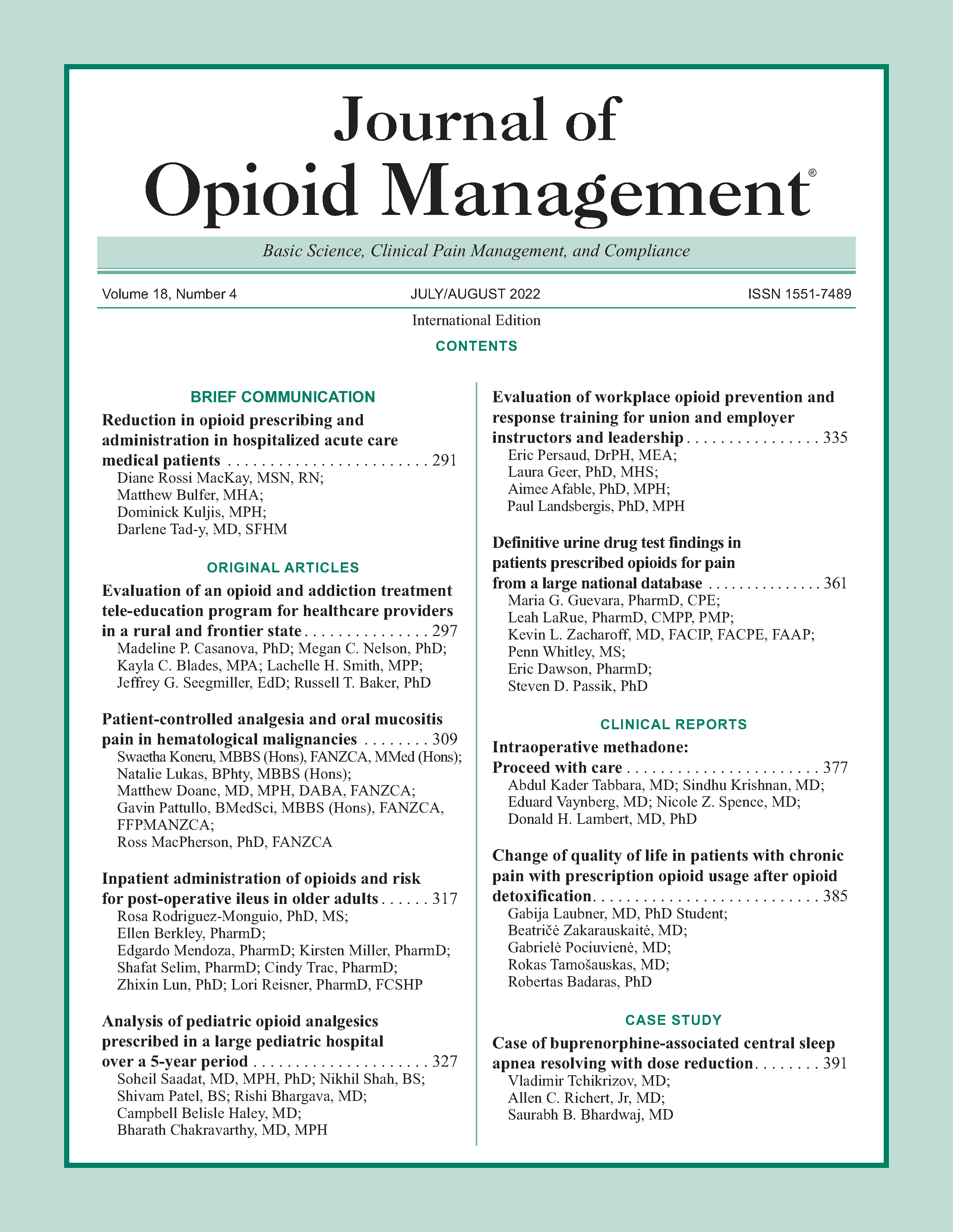Analysis of pediatric opioid analgesics prescribed in a large pediatric hospital over a 5-year period
DOI:
https://doi.org/10.5055/jom.2022.0728Keywords:
opioids, prescriptions, pediatrics, MME, hydrocodone, codeine, tramadolAbstract
Objective: In this study, we aim to look at opioid prescription patterns in a large pediatric hospital with an emphasis on opioid potency as measured by morphine milligram equivalents (MMEs) to understand physician response to safe prescribing regulations and new research on opioid use in pediatrics.
Design: Analgesic prescriptions in a pediatric hospital in California from 2012 to 2016 were included. Prescriptions that contained any type of opioid medication were analyzed total MME in each prescription, and medication prescribed. The MME for each opioid was assigned to the prescription and presented as mean ± standard deviation (SD). Statistical analysis was performed by using IBM SPSS statistics version 25.
Setting: A pediatric hospital in California.
Participants: All pediatric patients receiving analgesic prescriptions from a single institution between 2012 and 2016.
Main outcome measure: Relative frequency of different opioid medications prescribed.
Results: Of the 14,194 total opioid prescriptions, hydrocodone (11,247), codeine (2,117), and tramadol (411) were most prescribed. The relative frequency of opioid prescription decreased from 2012 to 2016 due to the decreased prescription of hydrocodone and codeine. Despite the decreased relative frequency of opioid prescription, the mean MME of prescribed opioids increased.
Conclusion: The study demonstrated that recent efforts to limit pediatric exposure to opioids have been effective. However, recommendations limiting the use of weak opioids (codeine and tramadol) have caused an increase in average prescribed opioid potency. This may be a contributing factor to the overall increase in opioid-related pediatric hospitalizations. Revision of prescription guidelines for hydrocodone (MME = 1) may protect pediatric patients from unnecessary opioid exposure.
References
Parikh JM, Amolenda P, Rutledge J, et al.: An update on the safety of prescribing opioids in pediatrics. Expert Opin Drug Saf. 2019; 18(2): 127-143. DOI: 10.1080/14740338.2019.1571037.
Ferland CE, Vega E, Ingelmo PM: Acute pain management in children: Challenges and recent improvements. Curr Opin Anaesthesiol. 2018; 31(3): 327-332. DOI: 10.1097/ACO.0000000000000579.
Verghese ST, Hannallah RS: Acute pain management in children. J Pain Res. 2010; 3: 105. DOI: 10.2147/JPR.S4554.
de Freitas GR, de Castro CG, Jr, Castro SM, et al.: Degree of knowledge of health care professionals about pain management and use of opioids in pediatrics. Pain Med. 2014; 15(5): 807-819. DOI: 10.1111/PME.12332.
Miech R, Johnston L, O’Malley PM, et al.: Prescription opioids in adolescence and future opioid misuse. Pediatrics. 2015; 136(5): e1169-e1177. DOI: 10.1542/PEDS.2015-1364.
McCabe SE, West BT, Veliz P, et al.: Trends in medical and nonmedical use of prescription opioids among US adolescents: 1976–2015. Pediatrics. 2017; 139(4): e20162387. DOI: 10.1542/PEDS.2016-2387.
Groenewald CB, Rabbitts JA, Gebert JT, et al.: Trends in opioid prescriptions among children and adolescents in the United States: A nationally representative study from 1996 to 2012. Pain. 2016; 157(5): 1021-1027. DOI: 10.1097/J.PAIN.0000000000000475.
Squeglia LM, Jacobus J, Tapert SF: The influence of substance use on adolescent brain development. Clin EEG Neurosci. 2009; 40(1): 31-38. DOI: 10.1177/155005940904000110.
Chua KP, Shrime MG, Conti RM: Effect of FDA investigation on opioid prescribing to children after tonsillectomy/adenoidectomy. Pediatrics. 2017; 140(6). DOI: 10.1542/PEDS.2017-1765.
Kelley-Quon LI, Kirkpatrick MG, Ricca RL, et al.: Guidelines for opioid prescribing in children and adolescents after surgery: An expert panel opinion. JAMA Surg. 2021; 156(1): 76–90. DOI: 10.1001/jamasurg.2020.5045.
Gomes T, Mamdani MM, Dhalla IA, et al.: Opioid dose and drug-related mortality in patients with nonmalignant pain. Arch Internal Med. 2011; 171(7): 686–691. DOI: 10.1001/archinternmed.2011.11712.
Bohnert AS, Valenstein M, Bair MJ, et al.: Association between opioid prescribing patterns and opioid overdose-related deaths. JAMA. 2011; 305(13): 1315-1321. DOI: 10.1001/JAMA.2011.370.
Tran S, Lavitas P, Stevens K, et al.: The effect of a federal controlled substance act schedule change on hydrocodone combination products claims in a medicaid population. J Manag Care Spec Pharm. 2017; 23(5): 532-539. DOI: 10.18553/JMCP.2017.23.5.532.
Jones CM: Frequency of prescription pain reliever nonmedical use: 2002-2003 and 2009-2010. Arch Intern Med. 2012; 172(16): 1265-1267. DOI: 10.1001/ARCHINTERNMED.2012.2533.
Organization WHO: The selection and use of essential medicines: Report of the WHO Expert Committee, March 2011 (including the 17th WHO model list of essential medicines and the 3rd WHO model list of essential medicines for children). 2012; xiv: 249 p.
Rodieux F, Vutskits L, Posfay-Barbe KM, et al.: When the safe alternative is not that safe: Tramadol prescribing in children. Front Pharmacol. 2018; 9: 148. DOI: 10.3389/fphar.2018.00148.
Williams DG, Hatch DJ, Howard RF: Codeine phosphate in paediatric medicine. Br J Anaesth. 2001; 86(3): 413–421. DOI: 10.1093/bja/86.3.413.
Brandow AM, DeBaun MR: Key components of pain management for children and adults with sickle cell disease. Hematol/Oncol Clin N Am. 2018; 32(3): 535–550. DOI: 10.1016/j.hoc.2018.01.014.
American Medical Association: Physicians’ actions to help end the nation’s drug-related overdose and death epidemic—and what still needs to be done. 2021. Available at https://end-overdose-epidemic.org/wp-content/uploads/2021/09/AMA-2021-Overdose-Epidemic-Report_92021.pdf. Accessed October 30, 2021.
Kane JM, Colvin JD, Bartlett AH, et al.: Opioid-related critical care resource use in US children’s hospitals. Pediatrics. 2018; 141(4): e20173335. DOI: 10.1542/peds.2017-3335.
Published
How to Cite
Issue
Section
License
Copyright 2005-2025, Weston Medical Publishing, LLC and Journal of Opioid Management. All Rights Reserved.











